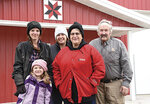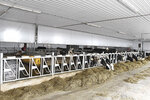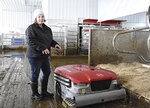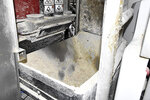OTTERTAIL, Minn. – The Larson family had reached a crossroads in their dairying career; their herd had grown beyond the capacity of the 74-year-old tiestall barn and the next generation was on the edge of returning to a worn-out facility.
To ensure the family could continue dairying, the Larsons decided to build a 69-stall freestall barn and install one Lely A5 Astronaut robot. They have been in the facility since February of this year.
“Family farms are what’s best for our local economy and infrastructure, what’s best for Minnesota,” Ken Larson said. “I truly believe (automation) was the best way for us to save this farm without milking more cows.”
Ken and his wife, Dori, milk 65 cows on their organic dairy farm, Silver Dust Farm, near Ottertail. They farm in partnership with their two grown children and their families – Ellen Dilly and her husband, Luke; and Todd and his wife, Melissa.
Ellen came back to farm full time in 2014 and now oversees the livestock portion of the operation. Dori does all the paperwork, while Todd and Melissa manage the crops and fieldwork; Todd also works off the farm as a trucker. Ken is as involved as he can be but is also employed full time for a dairy cooperative.
“This barn is a part of our long-term transition plan as we’re having those conversations with the next generation,” Dori said.
The 74- by 192-foot facility features a maternity pen on its west end with the robotic milking system separating the pen from the free stalls. This allows for accessibility of the robot without disturbing the milking herd.
Unlike many robotic systems that use a pellet to entice a cow for milking, the Larsons opted for loose feed.
“With loose feed, we can use our organic feed,” Ellen said. “Otherwise, the cost for those supplements would have been astronomical.”
Cows are housed on waterbed mattresses bedded with sawdust, and the pen is cleaned with a manure collector.
In addition to the barn, the Larsons put in a double-gate grazing management system and built a pump manure system to the north of the housing facility.
“When we were making plans for this, we wanted something that would save us in labor, have all the cows under one roof and a manure system that worked,” Ellen said. “Those were really our only requirements.”
About four years ago, the Larsons started tossing plans around. Milking cows was becoming too labor intensive for Silver Dust Farm – which has no non-family employees – and the younger generation was looking for more flexibility as dairy farmers.
They toured three retrofitted barns and one new build for ideas, but once the decision to go toward automation was made, the Larsons knew the direction they wanted for their farm.
“We were pretty adamant on only wanting one robot,” Ellen said. “We didn’t want more cows. We just wanted something that was going to give us more flexibility and less manual labor.”
Ken agreed.
“The extra time we have now and not being tied to a time gives Ellen time to go see her kids’ activities,” he said. “And, we noticed this summer that we put up better quality forages because we didn’t have to plan harvest around milking times.”
Dori especially likes how the technology closely monitors animal health. She can easily keep track of heats and has seen the herd’s pregnancy rate rise over the last year.
With nearly a year under their belts, the Larsons are pleased with the new system and how the cows have adjusted.
“It keeps getting better with each milking,” Ellen said.
But the first few months did not come without challenges. Not only did the herd have to figure out the automated milking system, the cows also had to learn how to function in a freestall barn, compared to the tiestall and pack barn previously used.
“Before the cows could eat, they had to figure out the headlocks. They also had to learn the robot and get out of (the manure collector’s) way,” Ellen said. “That first week, we were definitely second-guessing ourselves and this decision. We are appreciative of the help from Leedstone employees as they problem solved and worked with us during our start up.”
The Larsons’ entire family was on site during the first month to help the cows adjust to the new environment. It took another few months before someone did not need to be in the barn at all times.
“You go from touching the cows all the time to using a computer to tell you what’s going on,” Melissa said. “I’m glad we did it, but there was so much new stuff to learn.”
Dori agreed.
“It’s just a whole different way of milking cows,” said the second-generation farmer. “Growing up, I milked cows by hand. Now, (my grandson) just hops on the computer and has a handle on what’s going on.”
For the Larsons, dairy farming is a passion and a way of life they hope to continue for many more generations; and with a robot that may just be possible.
“If you can make the payments, it’s a good way to milk cows,” Ken said. “It’s easy on the body and consistent.”
Ellen agreed.
“For the cows, this just can’t be beat,” she said.




Comments
No comments on this item Please log in to comment by clicking here